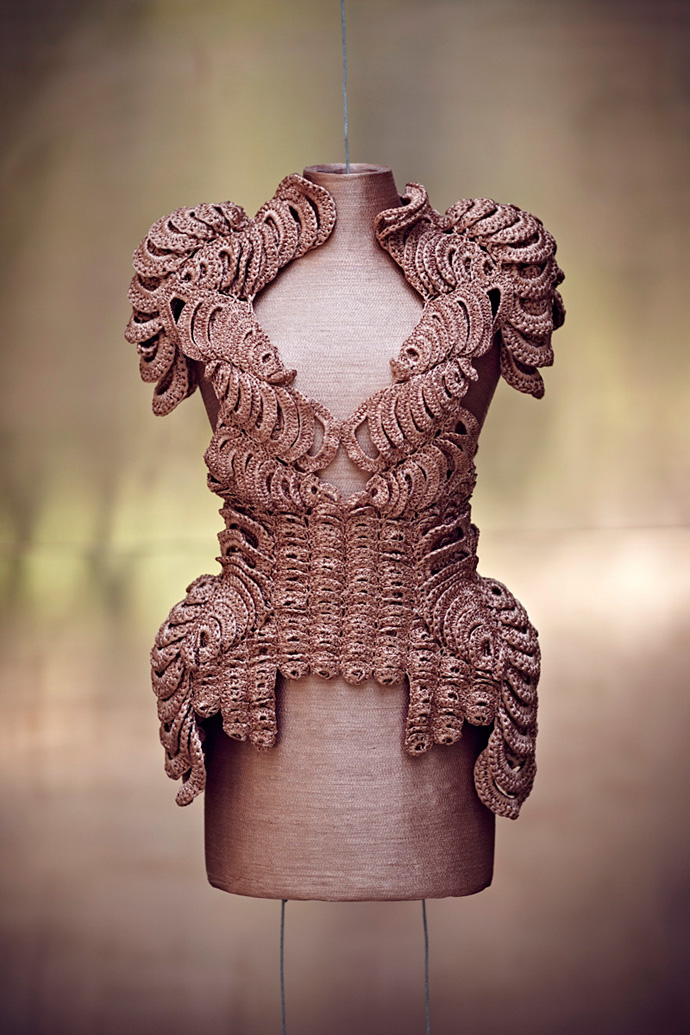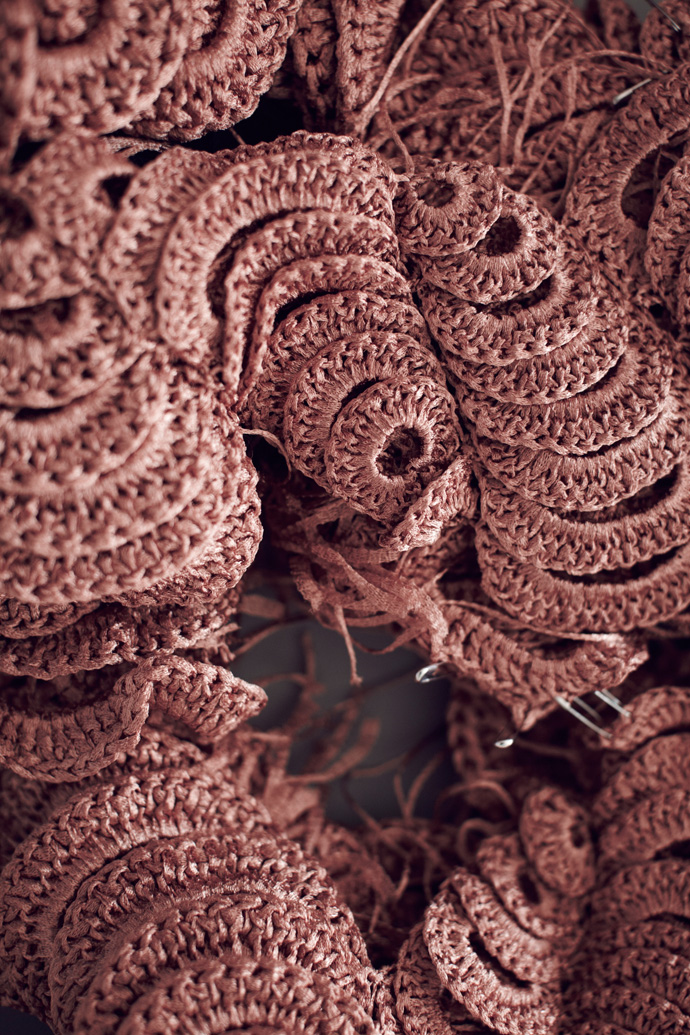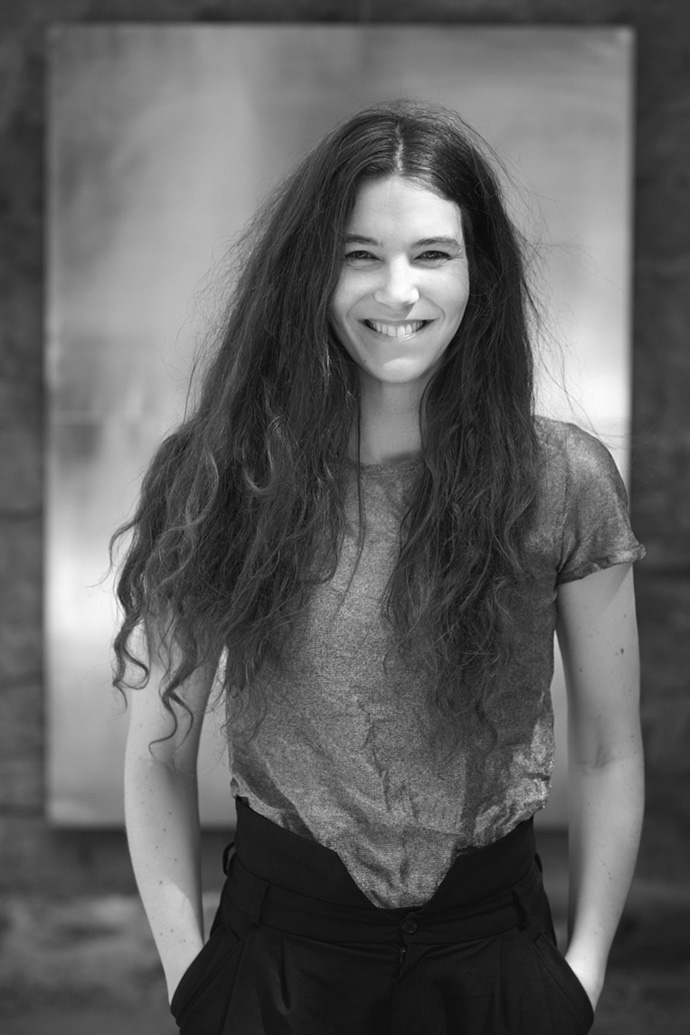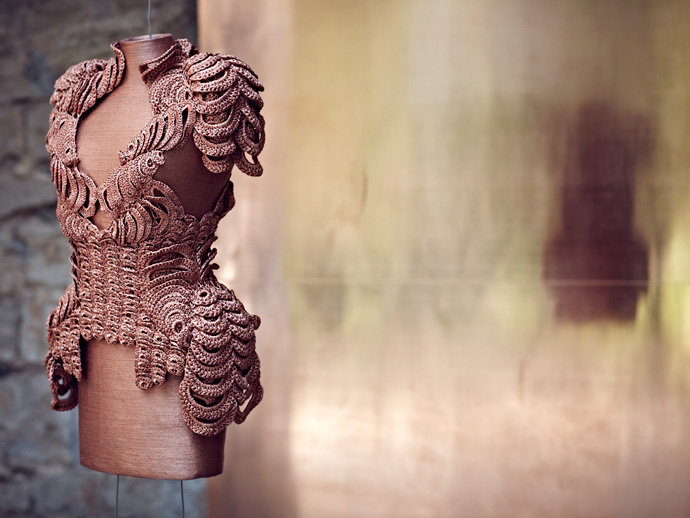-

SANDRA BACKLUND: is knitting herself to the top
-Wherever Sandra Backlund picks her thread it will lead to an incomparable result. That earned her the jury prize in Hyères 2008 and with it international recognition, on which Louis Vuitton had bought in shortly after. The dark Swede impresses with knit works that go far beyond the discipline of fashion and render the use of traditional artisan technique to visionary, body oriented sculptures. Looking at her latest installation CUPRUM 2010, it comes not as a surprise she had studied art history.
The Piece made entirely of finest copper yarn, was commissioned by the Villa Noailles for this years exhibition.The Stimuleye talked with Sandra about here recent work. The conversation was shortly interrupted by yet another request from the international glitteratti circuit: Sandra is truly knitting to the top!
 Sandra Backlund's installation CUPRUM 2010 at the Villa Noailles' pigeonnier. Photography by René Habermacher
Sandra Backlund's installation CUPRUM 2010 at the Villa Noailles' pigeonnier. Photography by René HabermacherRENÉ HABERMACHER: What was the point of departure for this installation and the inspiration behind it?
SANDRA BACKLUND: Everything took off from the position they gave me for my exhibition, the Pigeon House in the north garden of Villa Noailles. I think it’s a very beautiful space, so I wanted to use it as a frame, rather then just a location. Because the house is partly open and the exhibition would run for one month outside, I had to carefully consider what material to work with. Already for my current S/S 2011 collection I had been working with a metal yarn made from 100% copper, so in a way it came natural to me to continue exploring that material. With a history of use that is at least 10 000 years old, copper is an important part of both our history and the future. It’s one of the world’s most useful natural resources, 100% recyclable without any loss of quality and it’s estimated that 80% of the copper ever mined, is still in use today. In a way I feel like the story of copper as a material and the way I try to approach fashion go very well together.Can you explain me the process of planning, and the making of the dress?
As always, the handicraft techniques and the human body is the main starting point for me. I never sketch, instead I work with a three dimensional collage method where I develop some basic bricks that I multiply and attach to each other in different ways to discover the silhouette. The only thing I decided already from the beginning was that I wanted some kind of link between the signature piece (the paper origami top) of my winning collection from the 22nd edition of the festival in 2007. Because of the different techniques, materials and colours and because of the process, I guess in the end the link is not so obvious, but there is a few things that is still noticeable, like the silhouette and the size gradings for example.I’ve witnessed you working day and night on this piece – do you have a clue how many hours went into the making?
To be honest, I think that this is the longest piece I have ever worked on. First of all, crochet is always extremely time consuming, especially when it’s layered like this. The copper tape is also very fragile and ones it’s used it, it’s impossible to change, so I had let go of the control and in a way let faith guide me to the end result. If we are talking hours, my estimation is around 500-600 hours.
 Pieces of copper yarn in the the making, and Sandra at the exhibition space. Photography by René Habermacher
Pieces of copper yarn in the the making, and Sandra at the exhibition space. Photography by René HabermacherYour pieces are often very sculptural, with the artisan work involved, i wonder wether you consider to put your work in a different context than fashion?
Of course I have consider this and many times questioned if fashion is really the right context for my work. As you said, my clothes are always quite sculptural and I also use methods when working that is more close to a sculptor’s, then a tailor’s. But somehow I always come back to the human body. I like to consciously dress and undress different parts of the body and I am very fascinated by all the ways highlight, distort and transform the natural silhouette with clothes and accessories. For me fashion is also one of the most democratic art forms, something that we are all related to. You don’t have to be a designer or a stylist to use clothes as a creative statement, but people in general could of course be more self-governed when t comes to fashion.To me it seems difficult to render your unique approach into industrial production. How are your experiences with that?
About two years ago I was introduced to the long tradition of Italian top knitwear and apparel production. The challenge was to add to my collections something inspired by my hand made pieces that could require only a limited amount of manual work. It was of course a big step for me to go from working alone in my studio, inventing pieces while doing them myself by hand, to suddenly be working in a team of experts within a field of fashion that I never before have had the chance to get to know. I was overwhelmed by all the possibilities I saw and even though I will never give up doing my hand knitted signature pieces, these production tests really made me understand that there is ways to develop my collections that I never thought was possible.What is this festival of Hyères to you? How was it to win – and to be back for this project?
The whole event is really an experience for life when you’re a young designer, all the people you meet and the rush from showing your work in a context like that. I didn’t know about the festival before I met Diane Pernet and she suggested that I should apply. I was crazy happy already when I was selected for the finale and then the wind up… It’s really an important moment in my career so far and to be back again this year and meet everyone was kind of a flash back. When I think about it, I’m still a bit shocked that I was the winner.What’s up next?
F/W 2011-2012 production, S/S 2012 collection and some up coming exhibitions.
The dress weights over 6kg, made from an archaic material that was the first to be 100% recyclableFurther information on Sandra Backlund: sandrabacklund.com
The Exhibition at the Villa Noailles in Hyeres runs throughout May until the 29th10